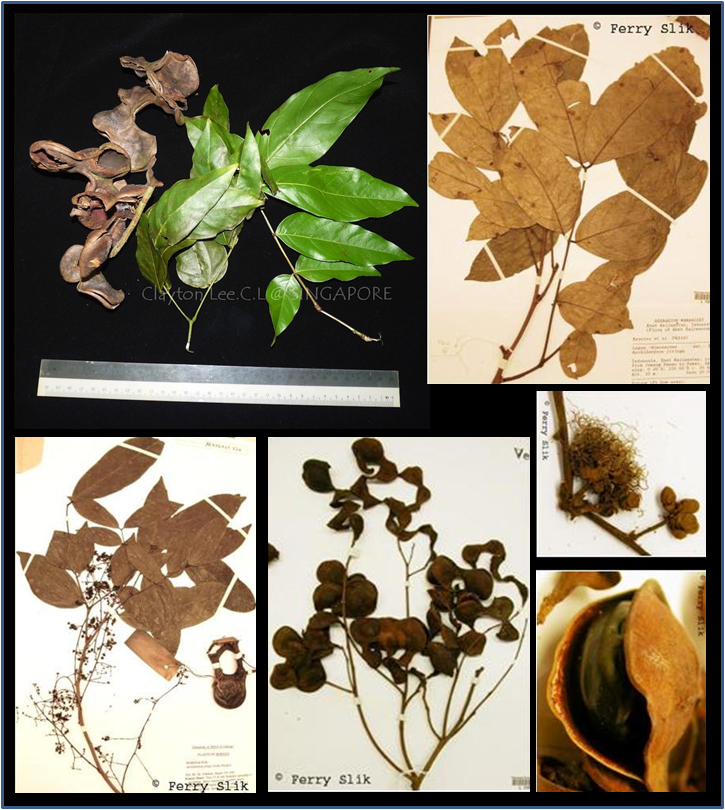Archidendron jiringa (Jack) Nielsen, Adansonia ser. 2, 19, 1 (1979)
Latin for ?Synonyms
Albizia jiringa (Jack) Kurz
Feuilleea jiringa (Jack) O.Kuntze
Inga jiringa Jack ex DC
Inga kaeringa (Roxb.) Voigt
Mimosa jiringa Jack
Mimosa kaeringa Roxb.
Pithecellobium jiringa (Jack) Prain
Pithecellobium lobatum Benth.
Zygia jiringa (Jack) Kosterm.
Description
Shrub or tree, to 24 m high, 60(-90) cm in diameter. Bark grey or grey-white, usually
smooth, rarely c. flaky, inner bark pink or reddish brown. Sapwood white or pinkish white, heartwood
white, with a strong smell of garlic. Branchlets terete with decurrent ridges
from the leaf-scars, light brown, glabrous. Leaves: petiole 2-7 cm, glabrous, gland(s) on petiole often
present, circular in outline, sessile, subglobose to flat, 1.5-2 mm in diameter; pinnae 1 pair, to
20 cm, glabrous; petiolules 4-6 mm, glabrous; leaflets 2 or 3 pairs per pinna, opposite, drying
c. dark greyish on both surfaces or green beneath, chartaceous, equal- or unequal-sided, ovate-elliptic
to oblong, 5.5-20.5 by 2.4-7 cm, base c. asymmetrically rounded to broadly cuneate, apex obtusely
acuminate, both surfaces glabrous; principal lateral veins c. 6-10 per leaflet-half, strongly arching,
non-parallel; reticulation fine, inconspicuous or prominulous on both surfaces, more distinct
beneath. Inflorescences either ramiflorous below the leaves or axillary at the distal leaves, with scattered
hairs in the distal parts, glabrescent, consisting of glomerules aggregated into panicles to 30
cm long; glomerules or small spikes composed of 4-7 sessile flowers; floral bracts ovate or ovate-elliptic,
acute, 0.5-1 mm, appressed-puberulous. Flowers cream or yellowish white, pentamerous,
bisexual. Calyx broadly campanulate to cup-shaped, 1-2 mm, scarcely puberulous especially
in the proximal part; teeth deltoid, acute, 0.2-0.3 mm. Corolla funnel-shaped, 4-5 mm, tube glabrous;
lobes ovate-elliptic to oblong, acute, c. 2 mm, appressed-puberulous or glabrous at the apex,
reflexed. Stamens c. 8-10 mm, tube equalling the corolla-tube. Ovary solitary, glabrous. Pod greyish
to dark brown or dark purple outside, greyish within, falcate or twisted in a wide spiral or contorted
into a circle c. 11 cm in diameter, c. deeply lobed between the seeds along the ventral suture, at maturity
most often divided quite down to the thickened dorsal suture, the segments being separated by
necks, pod woody, to 20-25 by 5.2 cm, glabrous, with inconspicuous veins, dehiscing along the
ventral suture. Seeds dark-brown, orbicular, biconvex, 2.8-3.5 cm in diameter, 1-1.5 cm thick.
[from Flora Malesiana]
Ecology
Primary and secondary rain forest, evergreen forest; often saved when the forest is cut. Cultivated around
villages. Soil sandy or clayey, lateritic; altitude 0-1000 m (up to 1627 m in Java).
Uses
Seeds contain the toxic djenkol acid, which can be removed after two or three boilings. Used for flavouring
food. Pods give a purple dye for silk; bark and leaves used for dyeing black; the leaves are used medicinally.
Roots also have medicinal properties.
Distribution
Bangladesh, Burma, Thailand, Peninsular Malaysia, Sumatra, Java, Borneo, Moluccas.
Local names
Borneo: Jaring, Jaring-jaring, Jengkol hutan, Jenkol, Jering, Jering altut, Tutung.
